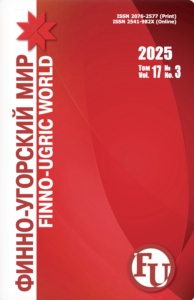Burnaev Aleksandr G.,
Doctor of Art History, Professor, Department of Theatrical Art and Folk Art Culture, Ogarev Mordovia State University (Saransk, Russia), burnaevag@mail.ru
Introduction. It raises the problem of preserving folk dance tradition of the Mordovians at the beginning of the XXI century. The object of the research is an autumn folk sheaf holiday devoted to collection of a new harvest; the subject is the content of the composition of this holiday, such as the dancing characteristics of tripping movements in the form of a folk ditty. The aim of the article is to analyze the ceremonial action of the sheaf holiday, which implies the identification of compositional aspects of the direction and production data of the song and dance texts; fundamentals of the genres of ethnic folk works of Moksha Mordovians; clarification and explanation of the choreographic manner of dance performance with sheaves; description of the ethnic tripping movements as a “mini-dance” in the form of a folk ditty and a comparative analysis of its local features. The novelty and topicality of the work is determined by the methods of collecting the field material, fixing it, preserving and broadcasting it to new generations. The material can be used in the study, in the stage and professional art, but in a reconstructed form.
Materials and Methods. For this work, a systematic cultural-historical approach, descriptive and comparative methods were used. The material of the study was field records made during the folk celebration of the sheaf holiday in the village Mordovsky Pimbur of the Republic of Mordovia.
Results and Discussion. At the beginning of the XXI century a new comprehensive study of ceremonial actions of the Mordovians, ethnic specificity of folk festivals, folkloric genres of ethnic works, choreographic components of Mordovian dance allow to show the cultural and historical experience of the ethnos, its comprehension and existence of the surviving dance traditions. The empirical data confirm the hypothesis on the need for a comprehensive study of the traditions of the Mordovian sub-ethnos, which implies the consideration of the rules of human behavior and the existence of genres of ethnic works in the framework of the festive ritual culture.
Conclusion. Currently, the traditions of Mordovian rites are preserved not only in the people’s environment, but also in theatrical festivals. P tripping movements as a genre of Mordovian ethnic work is performed as “mini-dance” in the form of a folk ditty, which is inseparable from small dance songs.
Key words: genre of ethnic work; ethnic tripping movements; ethnicity; composition and direction of the national holiday; direction of ritual action; dance ethnic text; figures of ethnic dance; pattern of ethnic dance; movements of ethnic dance.
For citation: Burnaev AG. Prazdnik snopa i pripliaska v forme narodnoi chastushki kak zhanry etnotvorchestva mordvy [Sheaf holiday and tripping movements in the form of folk ditty as the genres of the ethnic folk works of Mordovians]. Finno-ugorskii mir = Finno-Ugric World. 2017; 4: 96–106. (In Russian)
1. Bogdanov GF. Samobytnost’ russkogo tantsa [Originality of Russian dance]. Moskva; 2001. (In Russian)
2. Bryzhinskii VS. Mordovskie narodnye igry [Mordovian folk games]. Saransk; 2009. (In Russian)
3. Bryzhinskii VS. Narodnyi teatr mordvy [The People’s Theater of Mordovia]. Saransk; 1985. (In Russian)
4. Bryzhinskii VS. Serebrianye tsepochki [Silver chains]. Saransk; 2002. (In Russian)
5. Bulycheva NE. Fol’klor i fol’klorizm perioda formirovaniia professional’nykh traditsii (na materiale mordovskoi muzyki) [Folklore of the period of formation of professional traditions (on the material of Mordovian music)]. Saransk; 2003. (In Russian)
6. Burnaev AG. Kul’tura etnosa, voploshchennaia v tantse: monografiia [Culture of the ethnos, embodied in dance. Monograph]. Saransk; 2002. (In Russian)
7. Burnaev AG. Kul’turnaia model’ mordovskogo tantsa [Cultural model of Mordovian dance]. Saransk; 2007. (In Russian)
8. Burnaev AG. Mordovskii tanets (istoriia, metodika, praktika): ucheb. posobie [Mordovian dance (history, methodology, practice). Textbook]. Saransk; 2002. (In Russian)
9. Burnaev AG. Mordovskii tanets v kontekste finno-ugorskoi tantseval’noi kul’tury: monografiia [Mordovian dance in the context of the Finno-Ugric dance culture. Monograph]. Saransk; 2014. (In Russian)
10. Burnaev AG. Plasticheskie osobennosti tantsa mordvy-mokshi Zubovo-Polianskogo raiona Mordovii [Plastic features of the dance of the Mordva-moksha of the Zubovo-Polyansky district of Mordovia]. Tsentr i periferiia = Center and periphery. 2013; 4: 82–91. (In Russian)
11. Burnaev AG. Tantseval’naia kul’tura v kontekste dukhovnosti mordvy [Dance culture in the context of spirituality of Mordovians]. Algoritmy provintsial’noi zhizni: monografiia = Algorithms of provincial life. Monograph. Saransk; 2016: 313–416. (In Russian)
12. Burnaev AG. Tantseval’no-plasticheskaia kul’tura mordvy (opyt iskusstvovedcheskogo analiza): monografiia [Dance-plastic culture of the Mordovians (experience of art criticism analysis). Monograph]. Saransk; 2012. (In Russian)
13. Mel’nikov PI. Ocherki mordvy [Essays on the Mordovians]. Saransk; 1981. (In Russian)
14. Mokshin NF. Religioznye verovaniia mordvy [Religious beliefs of Mordovians]. Saransk; 1981. (In Russian)
15. PMA, 2013. Respublika Mordoviia, Zubovo-Polianskii raion, s. Zhukovka (informant Kidiaeva Aleksandra Vladimirovna, 1941 g. r. (72 goda)) [Republic Mordovia, Zubovo-Polianskij area, village Zhukovka (Kidiaeva Aleksandra Vladimirovna, born 1941 (72 y. o.))]. (In Russian)
16. PMA, 2013. Respublika Mordoviia, Zubovo-Polianskii raion, s. Zarubkino (informant Tiuzhaeva Irina Ivanovna, 1956 g. r. (57 let)) [Republic Mordovia, Zubovo-Polianskij area, village Zarubkino (Tiuzhaeva Irina Ivanovna, born 1956 (57 y. o.))]. (In Russian)
17. PMA, 2013. Respublika Mordoviia, Zubovo-Polianskii raion, s. Kargal (informant Sernabrina Proskov’ia Danilovna, 1938 g. r. (75 let)) [Republic Mordovia, Zubovo-Polianskij area, village Kargal (Sernabrina Proskov’ia Danilovna, born 1938 (75 y. o.))]. (In Russian)
18. PMA, 2013. Respublika Mordoviia, Zubovo-Polianskii raion, s. Mordovskii Pimbur (informant Chushkova Anna Vasil’evna, 1926 g. r. (87 let)) [Republic Mordovia, Zubovo-Polianskij area, village Mordovskii Pimbur (Chushkova Anna Vasil’evna, born 1926 (87 y. o.))]. (In Russian)
19. PMA, 2013. Respublika Mordoviia, Chamzinskii raion, s. Rybkino (informant Samarina Anna Petrovna, 1926 g. r. (87 let)) [Republic Mordovia, Zubovo-Polianskij area, village Rybkino (Samarina Anna Petrovna, born 1926 (87 y. o.))]. (In Russian)
20. Prokina TP, Surina MI. Mordovskii narodnyi kostium [Mordovian folk costume]. Saransk; 1990. (In Russian)
21. Tsentral’nyi gosudarstvennyi arkhiv RM [Central State Archive of the Republic of Mordovia]. F. R-267; 25: 25. (In Russian)
22. Iurchenkova NG. Mifologiia mordovskogo naroda [Mythology of the Mordovian people]. Saransk; 2006. (In Russian)






















